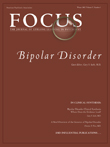From the Guest Editor
Count bipolar disorder among the things greatly changed over the past decade. Some of the changes are very exciting such as those related to genetics, neuroimaging and other studies that hint at the etiology of bipolar disorder as well as the substantial growth in the number of evidence based treatments available. Readers of this Focus edition will appreciate articles heralding important advances in our understanding of bipolar illness and its treatment.
Phenomenological studies improved our understanding by following the course of illness and revealing dominance of depression for most patients with Bipolar I and Bipolar II. Such studies also demonstrated that the illness is complicated by high rates of comorbidity, cognitive impairment, and vocational impairment. Neuroimaging/Neuropsychology research has begun to elucidate the pathophysiology underlying the phenomenology.
Only a few years ago our knowledge of therapeutic options beyond lithium was scant. There were no adequately powered randomized double-blind parallel group placebo controlled studies for any treatment until 1994. When lithium produced less than optimal results, the explanation often started and ended with consideration of whether a sub-optimal result reflected a sub-optimal lithium level. This discussion has been enriched by FDA approvals now granted to eight medications for treatment of mania, two for bipolar depression and four for maintenance indications. Furthermore, data is available supporting specific psychosocial interventions and service delivery models.
Admittedly the light of data remains dim, but breaking the darkness that surrounded treatment for so long is worthy of celebration. Now, the time for celebration is limited by a pace of information growth so accelerated that it is difficult to keep up. I hope you will find this issue of Focus brings you up to date on the most clinically relevant knowledge pertaining to bipolar disorder.



